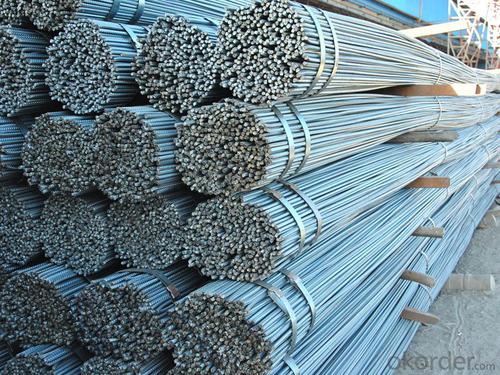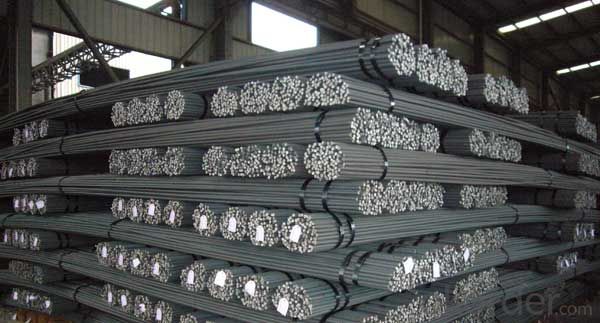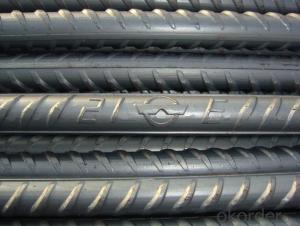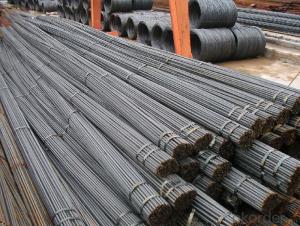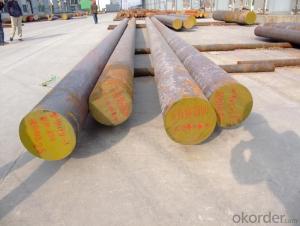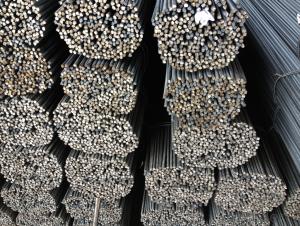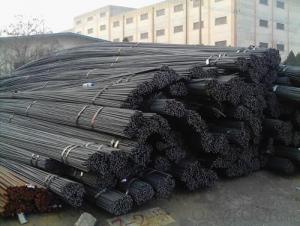Steel Rebar, Deformed Steel Bar,Iron Rods For Construction/Concrete/Building
- Loading Port:
- Shanghai
- Payment Terms:
- TT OR LC
- Min Order Qty:
- 100 m.t.
- Supply Capability:
- 1000 m.t./month
OKorder Service Pledge
OKorder Financial Service
You Might Also Like
deformed steel bar grade 40
material: HRB400, BS4449 GR460B
size: 8-36mmx12m.
short delivery time by bulk or container
deformed steel bar grade 40
material: HRB400, BS4449 GR460B
size: 8-36mmx12m.
short delivery time with bulk or container
packing: Mill standard export packing in bundles/coil, around 2tons/bundle.
country of Origin: China
delivery Time: Within a 35 days
Shipment: by bulk vessel or by container
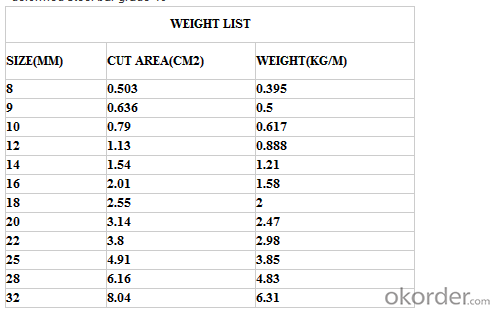
Leading goods:
section steel:angles,channels,I-beam,H-beam;
coils:cold/hot rolled coils,PPGI,galvanized coils,plate,checkered plate,cutting steel plate,steel strip;
wire rod:steel wire,deformed wire,bar;
pipe:seamless pipe,rectangular pipe,welded pipe,spiral welded pipe,pipe fittings;
stainless steel:steel sheets,stainless steel strips,stainless bar,stainless tube;
special:weathering steel,shipbuilding steel;
construction steel:C-channel,Z-channel,T-bar,high-speed divider plate,corrugated steel plate,steel grating.
Advantage:
We are the spot supplier, Six huge warehouses which can hold 20,000 MT goods.It makes the cost lower than others,we can provide the competitive price for you.
Delivery time:
Normal sizes can be provided in 7days, the others should be ready in 30---45 days.
Further treatment:
We can offer cutting,painting,drilling holes,bending,threading, welding,galvanization,packing etc.
Security interest:
We have already passed the ISO9001, BV and SGS authentication which makes the quality secured.
If you have the interest in any of the products we can provided, pls don't hesitate to connect with me. Looking forward to cooperate with you.
FAQ of Steel Deformed Bar
1. More than 10 years experience in this industry
2. 100,000 tons exporting per month
3. Professional foreign trade tea
4. OEM&ODM capacity
5. High quality assured & competitive price
6. Try our best to meet your needs & save your budget
7. Very popular in Southeast Asia, Africa, Mid-East and South America etc.
8. VIP membership system, first time customers and long-term cooperation customers can get extra discount on some products.
- Q: How do steel rebars affect the overall cost of maintenance?
- Steel rebars can significantly impact the overall cost of maintenance. By utilizing high-quality steel rebars in construction projects, the durability and strength of structures are enhanced, leading to reduced maintenance needs in the long run. The use of corrosion-resistant rebars can also prevent deterioration caused by environmental factors, lowering maintenance expenses. Conversely, using low-quality or substandard rebars may result in structural issues and increased maintenance costs over time.
- Q: How do steel rebars contribute to the overall aesthetics of a structure?
- Steel rebars do not necessarily contribute to the overall aesthetics of a structure as they are typically hidden within the concrete. However, they play a crucial role in reinforcing the concrete, ensuring structural integrity, and enhancing the durability and longevity of the building.
- Q: What is the effect of carbon content on the strength of steel rebars?
- The carbon content in steel rebars has a significant effect on their strength. Generally, a higher carbon content leads to increased strength and hardness in the steel rebars. This is because carbon atoms form strong chemical bonds with iron atoms in the steel matrix, resulting in a more rigid and durable material. When carbon is added to the steel, it forms carbides, which are crystalline compounds that make the steel harder and stronger. The presence of these carbides increases the resistance of the steel rebars to deformation, making them suitable for applications that require high strength, such as in construction and infrastructure projects. However, it is important to note that there is a limit to how much carbon can be added to the steel rebars to improve their strength. Excessive carbon content can make the steel brittle and susceptible to cracking under stress. This is because the excessive carbon atoms can form large carbide clusters, weakening the overall structure of the steel rebars. Therefore, the carbon content in steel rebars needs to be carefully balanced to achieve the desired strength and toughness. Depending on the specific application and requirements, different carbon levels can be used to optimize the strength and performance of the steel rebars. In conclusion, the carbon content has a direct impact on the strength of steel rebars. Increasing the carbon content can improve their strength and hardness, but excessive carbon levels can lead to brittleness. Thus, finding the right balance of carbon content is crucial to ensure the optimal strength and performance of steel rebars in various construction applications.
- Q: What is the process of reinforcing existing concrete structures with steel rebars?
- The process of reinforcing existing concrete structures with steel rebars involves several steps. First, a structural assessment is conducted to determine the areas that require reinforcement. Once identified, the concrete surface is prepared by cleaning and removing any loose or deteriorated material. Next, the rebars are positioned and secured to the existing concrete using epoxy adhesive or mechanical anchors. These rebars are strategically placed to distribute and support the additional load. Finally, the rebars are encased in a new layer of concrete called shotcrete or sprayed concrete, which acts as a protective and bonding layer. The result is a strengthened and more durable concrete structure capable of withstanding increased loads and extending its lifespan.
- Q: Can steel rebars be used in structures with limited construction regulations?
- Steel rebars can be used in structures with limited construction regulations, but it is important to note that the safety and structural integrity of the building may be compromised without proper regulations. Steel rebars are commonly used as reinforcement in concrete structures to provide strength and stability. However, the use of rebars alone does not guarantee the safety of a structure. Construction regulations exist to ensure that buildings are designed and constructed to withstand various forces and loads, such as wind, earthquakes, and live loads. These regulations also cover aspects such as fire safety, electrical systems, and accessibility. Without these regulations, there is a higher risk of structural failure or other safety issues. Using steel rebars in structures without proper construction regulations may result in buildings that are not adequately designed or constructed to withstand these forces and loads. This can lead to structural failure, collapse, or other hazards. It is therefore advisable to adhere to local construction codes and regulations to ensure the safety and longevity of any structure.
- Q: Are steel rebars suitable for use in historical building restoration?
- Steel rebars can be suitable for use in historical building restoration, but careful consideration should be given to the specific requirements of the project and the significance of the building. Steel rebars offer strength, durability, and ease of installation, which can be advantageous in reinforcing and stabilizing historical structures. However, it is important to ensure that the steel rebars do not compromise the original character and integrity of the building. In some cases, historical buildings may have specific preservation guidelines that prohibit or restrict the use of steel rebars. For instance, if the building is listed as a protected monument, the use of steel rebars may be limited to ensure the preservation of its original materials and construction methods. In such instances, alternative reinforcement materials like timber, stone, or even composite materials may be more appropriate. Additionally, it is crucial to consult with preservation experts, architects, and structural engineers who specialize in historical building restoration. They can provide valuable insights and recommendations on the most suitable reinforcement options for the specific project. Their expertise can help strike a balance between the structural needs of the building and the preservation of its historical value. Ultimately, the suitability of steel rebars for use in historical building restoration depends on a thorough assessment of the building's historical significance, the specific requirements of the restoration project, and adherence to preservation guidelines. With careful planning and consideration, steel rebars can be successfully incorporated into the restoration process, ensuring the longevity and stability of the historical structure while preserving its unique heritage.
- Q: What are the common grades of steel rebars?
- The common grades of steel rebars are typically categorized by their yield strength, which is the amount of force required to deform or bend the steel. The most common grades of steel rebars include Grade 40, Grade 60, and Grade 75. Grade 40 steel rebars have a minimum yield strength of 40,000 pounds per square inch (psi) and are commonly used in general construction projects where moderate strength is required. Grade 60 steel rebars have a minimum yield strength of 60,000 psi and are widely used in reinforced concrete structures such as bridges, buildings, and highways. They offer higher strength and durability compared to Grade 40 rebars, making them suitable for heavy-duty applications. Grade 75 steel rebars have a minimum yield strength of 75,000 psi and are commonly used in high-rise buildings, dams, and other structures that require exceptional strength and load-bearing capacity. These rebars provide the highest level of strength and are specifically designed for structures exposed to extreme conditions or heavy loads. It is important to note that the specific grade of steel rebars required for a particular project is determined by structural engineers and is based on factors such as the expected loads, environmental conditions, and design specifications.
- Q: What are the different types of steel rebars?
- There are several types of steel rebars, including black rebar, epoxy-coated rebar, galvanized rebar, stainless steel rebar, and glass fiber-reinforced polymer (GFRP) rebar. Each type is designed to serve specific purposes and offer unique properties to meet various construction requirements.
- Q: Can steel rebars be used in high-temperature environments?
- No, steel rebars should not be used in high-temperature environments as they can lose their strength and structural integrity due to thermal expansion and potential degradation.
- Q: Can steel rebars be used in fire-resistant structures?
- Yes, steel rebars can be used in fire-resistant structures. The high melting point and strength of steel make it a suitable material for reinforcing concrete in buildings that need to withstand fire. Additionally, steel rebars are often coated with fire-resistant materials to enhance their fire resistance properties.
Send your message to us
Steel Rebar, Deformed Steel Bar,Iron Rods For Construction/Concrete/Building
- Loading Port:
- Shanghai
- Payment Terms:
- TT OR LC
- Min Order Qty:
- 100 m.t.
- Supply Capability:
- 1000 m.t./month
OKorder Service Pledge
OKorder Financial Service
Similar products
Hot products
Hot Searches
Related keywords



